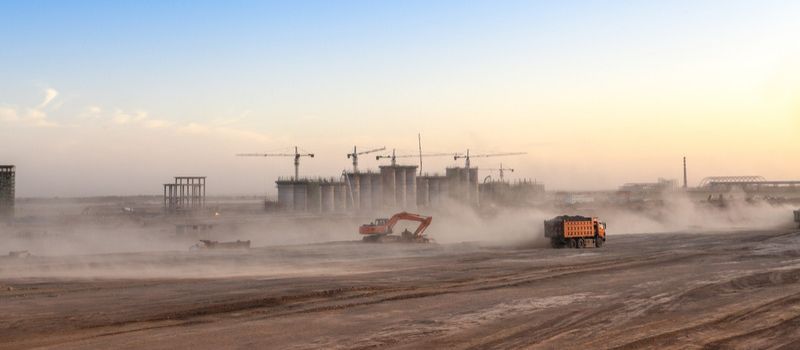
Did you know that only 0.5% of the water on earth is fresh and available for human use?
A fraction of that is considered potable water, meaning that it is safe for drinking and consumption. Around the world, millions of people do not have access to potable water. Conserving water has become increasingly important as many communities face climate change. ESG reporting has now entered the room.
There are many activities that occur every day on construction sites around the world that are incredibly water intensive. Not only is water in high-demand on these sites, but potable water is also often used in situations that don’t require it. Some of the most water-intensive processes on construction sites include dust suppression, material production, and concrete washout. ESG construction reporting will be a big ask for many projects in the near future so tracking water on the job site is becoming increasingly important. Try implementing some of the simple and effective strategies outlined below.

Dust Suppression
Dust control is a critical activity that is essential to human health, safety, and pollution prevention on construction sites. Water is often used to wet surfaces to prevent dust particles from getting into the air we breathe. Reducing the speed of vehicles on site, limiting soil disturbance, using vegetation, and using a dust collection system can all greatly reduce the water demand for dust suppression. If water must be used, consider using recycled or nonpotable water sources (more on that later).
Material Production
Concrete is the 2nd most used material around the world. It takes as much as 45 gallons of water required to produce one cubic meter of concrete. Recycled water for the concrete production process reduces the amount of fresh mains water consumed.
The recycling process is simple and removes many of the issues traditionally associated with managing concrete washout on site.
- Concrete skips, trucks and pumps are washed out into a tray that captures and contains the water.
- Filtration bags in the tray filter out the large particles. The filtration bags can be lifted from the tray and disposed of.
- Smaller sediment particles settle and the water flows over a weir into the next section.
- The visibly clean, but alkaline water filters into the final section of the tray where it is pumped into a storage tank.
- The pump in the water tank pumps the water into an empty delivery truck after a completed pour, which returns to the production facility.
The water can also be reused for wet-curing concrete structures or washing out concrete skips, trucks and pump lines.
Concrete Washout
Concrete production applications require ongoing wastewater management in order to keep operations running. Not only is wastewater management necessary to stay within regulatory guidelines, but excess waste can reduce profits, slow down operations, and can lead to environmental harm/damage. Drivers can use as much as 850 gallons of fresh water to wash out their mixers at the end of their shifts.
Treating concrete washout wastewater on site can keep water cleanliness high and costs low. Paying an outside company to transport and treat the wastewater is one way to go, but this is costly and inefficient. It also limits the ability to reuse water. Treating wastewater on-site with filtration methods provides a number of benefits, including
- Significant cost and efficiency savings
- Long-term sustainability improvements
- The ability to reuse the water once treated for a near closed-loop solution
Some producers are using only 50 gallons of water mixed with 32 ounces of a mix stabilizer. The wash water is left in the mixer overnight and reused the next day. The Florida DOT did a study on reusing chemically stabilized wash water and its impact on concrete strength and performance. Their final report confirmed the general acceptability of this practice.

ESG construction reporting will be a big ask for many projects in the near future so tracking and reducing water on the job site is becoming increasingly important. In addition to the strategies discussed above, there are actions each project team can take to reduce the total amount of water that is needed to perform integral construction activities:
Discuss water management on site early.
Before groundbreaking, gather project stakeholders to create a site-specific Water Management Plan. Think about all of the site activities that you anticipate will need water. Think about ways to reduce the amount of water that is needed, and consider if nonpotable water can be used for each activity.
You can’t manage what you don’t measure.
Installing water meters on site can help you understand how much water is being used and at what time. This will be helpful in evaluating the success of water reduction initiatives on your site.
Inspections
It’s important to regularly inspect pipes and hoses on the jobsite. Meters can also help detect leaks early, helping you eliminate wasted water.

Use Alternative Water Sources.
Rainwater collected on-site can be used for a variety of purposes, including tool & vehicle washing, dust suppression, landscape irrigation, and more. Rain barrels are an easy and cost-effective way to collect rainwater. On large or long-term projects, consider greywater systems that can help collect the water used in office trailers.
Jobsite Signage
Signage is a simple yet effective way to remind all workers on the site to be mindful of water use. Signage can include reminders to only use what is needed, opt for a bucket of water instead of a running hose when possible, and report leaks – even if they are minor.





